Changes to the Feet During Pregnancy
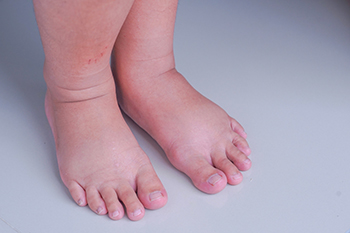
Pregnancy is a much-anticipated journey for many women, often filled with numerous physical changes, and the feet are no exception. During this transformative time, many women experience various alterations in their feet, which can be from hormonal shifts and increased weight. One common change is the flattening of the arches, caused by the hormone relaxin. This is effective in loosening the ligaments and joints in preparation for childbirth. As a result, some women may experience pain and discomfort in the feet and ankles. Swelling, also known as edema, is another prevalent issue, as the body retains more fluids during pregnancy. This can lead to a feeling of heaviness and tightness in the feet. To alleviate these symptoms, pregnant women are advised to wear comfortable and supportive footwear, elevate their feet when possible, and perform foot stretches and exercises. It's essential to prioritize foot health during pregnancy to ensure a smoother and more enjoyable journey to motherhood. It is suggested for women who are pregnant include a podiatrist in their healthcare team who can treat any foot conditions that may arise.
Pregnant women with swollen feet can be treated with a variety of different methods that are readily available. For more information about other cures for swollen feet during pregnancy, consult with Dr. Joshua David Scoll from Pennsylvania. Our doctor will attend to all of your foot and ankle needs.
What Foot Problems Can Arise During Pregnancy?
One problem that can occur is overpronation, which occurs when the arch of the foot flattens and tends to roll inward. This can cause pain and discomfort in your heels while you’re walking or even just standing up, trying to support your baby.
Another problem is edema, or swelling in the extremities. This often affects the feet during pregnancy but tends to occur in the later stages.
How Can I Keep My Feet Healthy During Pregnancy?
- Wearing orthotics can provide extra support for the feet and help distribute weight evenly
- Minimize the amount of time spent walking barefoot
- Wear shoes with good arch support
- Wear shoes that allow for good circulation to the feet
- Elevate feet if you experience swelling
- Massage your feet
- Get regular, light exercise, such as walking, to promote blood circulation to the feet
If you have any questions please feel free to contact one of our offices located in Philadelphia, Bensalem, and Fairless Hills, PA . We offer the newest diagnostic and treatment technologies for all your foot and ankle needs.
Socks Help Protect the Feet From Running Injuries
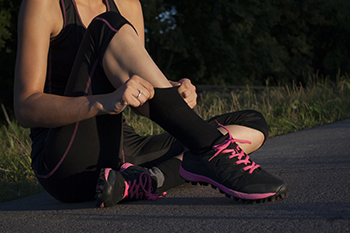
Much attention is placed on finding the proper running shoes for your feet and the type of running you will be doing. However, finding the right socks can be equally important to avoid discomfort and injury while running. The right running socks can help to prevent blisters, pad the feet, offer support, and wick away moisture. Running socks have certain attributes that normal socks don’t have. First, they are seamless, which can help to eliminate the rubbing and friction that encourages the formation of blisters. Second, while wearing running socks may not be the same as having insoles, many will contain a compression band that adds support and improves the fit. Third, many running socks also include cushioning for the ball of the foot and the heel. Finally, double-layer socks absorb the friction between the layers rather than on the skin. For more help with this and other ways to prevent running injuries, it is suggested that you make an appointment with a podiatrist.
Exercising your feet regularly with the proper foot wear is a great way to prevent injuries. If you have any concerns about your feet, contact Dr. Joshua David Scoll of Pennsylvania. Our doctor will treat your foot and ankle needs.
How to Prevent Running Injuries
Many common running injuries are caused by overuse and overtraining. When the back of the kneecap starts wearing out and starts causing pain in your knee, this is commonly referred to as runner’s knee. Runner’s knee is a decrease in strength in your quadriceps and can occur if you’re not wearing properly fitted or supporting shoes. To prevent runner’s knee, focusing on hip strengthening is a good idea, as well as strengthening your quads to keep the kneecaps aligned.
What Are Some Causes of Running Injuries?
- One cause of a common running injury is called iliotibial band syndrome.
- Plantar fasciitis is also another common injury.
- Stress fractures can occur from overtraining, lack of calcium, or even your running style.
Best Ways to Prevent Running Injuries
- Wear footwear that fits properly and suits your running needs.
- Running shoes are the only protective gear that runners have to safeguard them from injury.
- Make a training schedule. Adding strengthening exercises as well as regular stretching can help keep you strong and limber and can lessen the possibility of injuries.
- Stretching keeps muscles limber; this will help you gain better flexibility.
If you have any questions please feel free to contact one of our offices located in Philadelphia, Bensalem, and Fairless Hills, PA . We offer the newest diagnostic and treatment technologies for all your foot and ankle needs.
How Rheumatoid Arthritis Affects the Feet
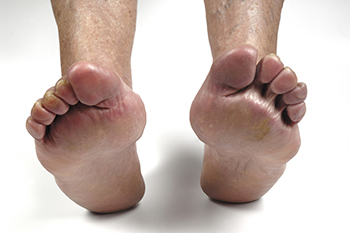
Rheumatoid arthritis is an autoimmune disease that causes inflammation in the joints. Because the feet have numerous joints, they are often a target for this disease. Tenderness, swelling, and stiffness in the joints are the major symptoms of rheumatoid arthritis or RA. Loss of range of motion and joint deformity are other symptoms. Foot deformities, such as bunions or hammertoes, can be caused by the erosion of the joints from RA. Because there is such a high risk of damage to the feet because of rheumatoid arthritis, it is wise to get a diagnosis sooner than later. Treatment can include medication, low-impact exercises, customized orthotics, and footwear recommendations. A podiatrist can fit the patient with orthotics built to fit the foot precisely and provide the necessary support and cushioning. For more information on how to deal with rheumatoid arthritis that is affecting the feet, it is suggested that you make an appointment with a podiatrist.
Because RA affects more than just your joints, including the joints in your feet and ankles, it is important to seek early diagnosis from your podiatrist if you feel like the pain in your feet might be caused by RA. For more information, contact Dr. Joshua David Scoll of Pennsylvania. Our doctor will assist you with all of your podiatric concerns.
What Is Rheumatoid Arthritis?
Rheumatoid Arthritis (RA) is an autoimmune disorder in which the body’s own immune system attacks the membranes surrounding the joints. Inflammation of the lining and eventually the destruction of the joint’s cartilage and bone occur, causing severe pain and immobility.
Rheumatoid Arthritis of the Feet
Although RA usually attacks multiple bones and joints throughout the entire body, almost 90 percent of cases result in pain in the foot or ankle area.
Symptoms
- Swelling and pain in the feet
- Stiffness in the feet
- Pain on the ball or sole of feet
- Joint shift and deformation
Diagnosis
Quick diagnosis of RA in the feet is important so that the podiatrist can treat the area effectively. Your doctor will ask you about your medical history, occupation, and lifestyle to determine the origin of the condition. Rheumatoid Factor tests help to determine if someone is affected by the disease.
If you have any questions please feel free to contact one of our offices located in Philadelphia, Bensalem, and Fairless Hills, PA . We offer the newest diagnostic and treatment technologies for all your foot and ankle needs.
Happy Feet 101
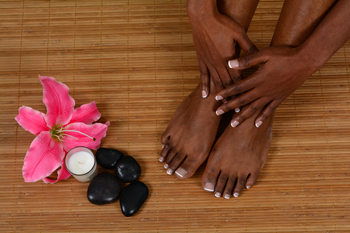
People seldom pay attention to their feet unless they hurt. Given all that the feet do for us in getting us around, keeping us upright, and providing independence, it would behoove us to give them some loving attention. If we do not do this, the feet are bound to endure problems, ranging from bad odor to painful foot afflictions. Foot care tips to keep the feet happy and healthy include washing, drying, and moisturizing the feet each day, cutting toenails straight across and rounding edges with a nail file, wearing shoes that fit well, checking the feet regularly for abnormalities, and even getting a pampering foot massage and pedicure periodically. If your feet are tired, a good soak and rest will help. If you want to learn more about how to take care of your feet so that they serve you well across your lifetime, make an appointment with a podiatrist who can provide routine foot exams and additional foot care tips.
Everyday foot care is very important to prevent infection and other foot ailments. If you need your feet checked, contact Dr. Joshua David Scoll from Pennsylvania. Our doctor can provide the care you need to keep you pain-free and on your feet.
Everyday Foot Care
Often, people take care of their bodies, face and hair more so than they do for their feet. But the feet are a very important aspect of our bodies, and one that we should pay more attention to. Without our feet, we would not be able to perform most daily tasks.
It is best to check your feet regularly to make sure there are no new bruises or cuts that you may not have noticed before. For dry feet, moisturizer can easily be a remedy and can be applied as often as necessary to the affected areas. Wearing shoes that fit well can also help you maintain good foot health, as well as making it easier to walk and do daily activities without the stress or pain of ill-fitting shoes, high heels, or even flip flops. Wearing clean socks with closed shoes is important to ensure that sweat and bacteria do not accumulate within the shoe. Clean socks help to prevent Athlete’s foot, fungi problems, bad odors, and can absorb sweat.
If you have any questions please feel free to contact one of our offices located in Philadelphia, Bensalem, and Fairless Hills, PA . We offer the newest diagnostic and treatment technologies for all your foot and ankle needs.
Common Symptoms of Plantar Fasciitis

The plantar fascia is found on the sole of the foot and consists of tissues that are tightly packed under the skin. Plantar fasciitis is characterized by heel pain when these tissues become inflamed and irritated from various things. These can include standing on hard or uneven surfaces for most of the day, or wearing shoes that do not fit correctly. It may also happen from weight gain, or from repetitive motion while performing specific activities. Having poor circulation may also lead to developing plantar fasciitis, as a result of reduced blood flow to the plantar fascia. It is beneficial to wear shoes that have a cushioned heel, and this may help to prevent plantar fasciitis. There are also stretches that can be done which can strengthen the plantar fascia. These can include standing on a step while lowering one heel at a time until a gentle stretch is felt. If you have heel pain, it is strongly suggested that you are under the care of a podiatrist who can help you find treatment and relief remedies for plantar fasciitis.
Plantar fasciitis is a common foot condition that is often caused by a strain injury. If you are experiencing heel pain or symptoms of plantar fasciitis, contact Dr. Joshua David Scoll from Pennsylvania. Our doctor can provide the care you need to keep you pain-free and on your feet.
What Is Plantar Fasciitis?
Plantar fasciitis is one of the most common causes of heel pain. The plantar fascia is a ligament that connects your heel to the front of your foot. When this ligament becomes inflamed, plantar fasciitis is the result. If you have plantar fasciitis you will have a stabbing pain that usually occurs with your first steps in the morning. As the day progresses and you walk around more, this pain will start to disappear, but it will return after long periods of standing or sitting.
What Causes Plantar Fasciitis?
- Excessive running
- Having high arches in your feet
- Other foot issues such as flat feet
- Pregnancy (due to the sudden weight gain)
- Being on your feet very often
There are some risk factors that may make you more likely to develop plantar fasciitis compared to others. The condition most commonly affects adults between the ages of 40 and 60. It also tends to affect people who are obese because the extra pounds result in extra stress being placed on the plantar fascia.
Prevention
- Take good care of your feet – Wear shoes that have good arch support and heel cushioning.
- Maintain a healthy weight
- If you are a runner, alternate running with other sports that won’t cause heel pain
There are a variety of treatment options available for plantar fasciitis along with the pain that accompanies it. Additionally, physical therapy is a very important component in the treatment process. It is important that you meet with your podiatrist to determine which treatment option is best for you.
If you have any questions, please feel free to contact one of our offices located in Philadelphia, Bensalem, and Fairless Hills, PA . We offer the newest diagnostic and treatment technologies for all your foot care needs.
Symptoms of Sever’s Disease

Sever’s disease is a condition that affects the heels in active children and young teenagers. Participating in running and jumping sporting events may cause Sever’s disease, as a result of, pressure on the heel. Sever’s disease is named after the American doctor James Sever, who discovered this condition in 1912. The heel pain that happens with Sever's disease generally occurs during a growth spurt and may be accompanied by swollen feet. Parents may notice their child is limping or walking on their tiptoes, and this can indicate Sever’s disease. Relief can begin with temporarily stopping the activity that caused this condition, in addition to frequently elevating the foot. As the affected foot heals, there may be specific stretches that can be done that can strengthen the heel. If your child has heel pain, it is strongly suggested that you consult with a podiatrist who can effectively treat Sever’s disease.
Sever's disease often occurs in children and teens. If your child is experiencing foot or ankle pain, see Dr. Joshua David Scoll from Pennsylvania. Our doctor can treat your child’s foot and ankle needs.
Sever’s Disease
Sever’s disease is also known as calcaneal apophysitis, which is a medical condition that causes heel pain I none or both feet. The disease is known to affect children between the ages of 8 and 14.
Sever’s disease occurs when part of the child’s heel known as the growth plate (calcaneal epiphysis) is attached to the Achilles tendon. This area can suffer injury when the muscles and tendons of the growing foot do not keep pace with bone growth. Therefore, the constant pain which one experiences at the back of the heel will make the child unable to put any weight on the heel. The child is then forced to walk on their toes.
Symptoms
Acute pain – Pain associated with Sever’s disease is usually felt in the heel when the child engages in physical activity such as walking, jumping and or running.
Highly active – Children who are very active are among the most susceptible in experiencing Sever’s disease, because of the stress and tension placed on their feet.
If you have any questions, please feel free to contact one of our offices located in Philadelphia, Bensalem, and Fairless Hills, PA . We offer the newest diagnostic and treatment technologies for all your foot and ankle injuries.
Recovery From a Broken Ankle
 If you have ever broken your ankle, you know how it can interfere with daily function and put a halt to many activities. It is crucial to promptly see a podiatrist who can evaluate the severity of the break and provide a treatment plan for recovery. Included in the recovery, at some point, will likely be movements that are designed to improve the strength, flexibility, and stability of the ankle. Once your cast or brace is removed, you may benefit from practicing several range of motion exercises. Simple movements, such as pointing the toes up and down and inward and outward, improve the ankle joint's motion. Flexibility exercises are for helping improve the muscular flexibility of the ankle. They include towel calf stretches and standing runner stretches. Strengthening exercises are for increasing the strength in an ankle that is weak from the fracture and immobilization. Resistance bands can be used to help perform these movements more comfortably. If you have a broken ankle, it is suggested that you see a podiatrist who can provide a plan for proper healing that will get you back to your normal functioning as quickly as possible and help future problems from the break down the road.
If you have ever broken your ankle, you know how it can interfere with daily function and put a halt to many activities. It is crucial to promptly see a podiatrist who can evaluate the severity of the break and provide a treatment plan for recovery. Included in the recovery, at some point, will likely be movements that are designed to improve the strength, flexibility, and stability of the ankle. Once your cast or brace is removed, you may benefit from practicing several range of motion exercises. Simple movements, such as pointing the toes up and down and inward and outward, improve the ankle joint's motion. Flexibility exercises are for helping improve the muscular flexibility of the ankle. They include towel calf stretches and standing runner stretches. Strengthening exercises are for increasing the strength in an ankle that is weak from the fracture and immobilization. Resistance bands can be used to help perform these movements more comfortably. If you have a broken ankle, it is suggested that you see a podiatrist who can provide a plan for proper healing that will get you back to your normal functioning as quickly as possible and help future problems from the break down the road.
Broken ankles need immediate treatment. If you are seeking treatment, contact Dr. Joshua David Scoll from Pennsylvania. Our doctor can provide the care you need to keep you pain-free and on your feet.
Broken Ankles
A broken ankle is experienced when a person fractures their tibia or fibula in the lower leg and ankle area. Both of these bones are attached at the bottom of the leg and combine to form what we know to be our ankle.
When a physician is referring to a break of the ankle, he or she is usually referring to a break in the area where the tibia and fibula are joined to create our ankle joint. Ankles are more prone to fractures because the ankle is an area that suffers a lot of pressure and stress. There are some obvious signs when a person experiences a fractured ankle, and the following symptoms may be present.
Symptoms of a Fractured Ankle
- Excessive pain when the area is touched or when any pressure is placed on the ankle
- Swelling around the area
- Bruising of the area
- Area appears to be deformed
If you suspect an ankle fracture, it is recommended to seek treatment as soon as possible. The sooner you have your podiatrist diagnose the fracture, the quicker you’ll be on the way towards recovery.
If you have any questions, please feel free to contact one of our offices located in Philadelphia, Bensalem, and Fairless Hills, PA . We offer the newest diagnostic and treatment technologies for all your foot care needs.
Purchasing Shoes Online
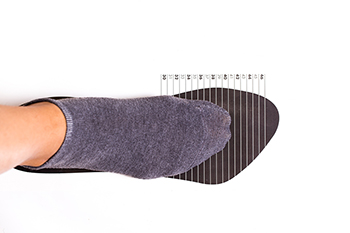
Shopping for shoes online has become increasingly popular despite the inability to try the desired shoes on before purchasing them. For people who prefer this method of buying shoes, it is beneficial that their feet are measured. Determining your correct shoe size can easily be accomplished. This can be done by standing on a piece of paper and tracing the foot. It is important to measure both length and width, and it may be easier to have a family member or friend do this. This is followed by using a conversion chart to find the right size. The height of the arch can be seen when the foot is dipped in water, followed by stepping on a piece of cardboard. A full footprint may indicate low arches. Conversely, if half the footprint is visible, this can be a sign of having high arches. If you would like to learn more about how to measure your foot for the correct shoe size, it is suggested that you confer with a podiatrist who can answer any questions you may have.
Getting the right shoe size is an important part of proper foot health. Seek the assistance of Dr. Joshua David Scoll from Pennsylvania. Our doctor will provide the care you need to keep you pain-free and on your feet.
Getting the Right Shoe Size
There are many people who wear shoes that are the incorrect size, negatively affecting their feet and posture. Selecting the right shoes is not a difficult process, so long as you keep several things in mind when it comes to choosing the right pair.
- When visiting the shoe store, use the tools available to measure your foot.
- Be sure there is ‘wiggle room’. There should be about an inch between your toes and the tip of your shoes.
- Do not always assume you are the same size, as manufacturers run differently.
- Purchase shoes later in the day, as your feet swell as the day progresses.
- If a shoe is not comfortable, it is not suitable. Most shoes can’t be ‘broken in’, and comfort should be the ultimate goal when it comes to choosing the right pair of shoes
As our feet hold our body weight and keep us moving, it is important to treat them right. Picking the right pair of shoes can provide your feet comfort and mobility without pain.
If you have any questions, please feel free to contact one of our offices located in Philadelphia, Bensalem, and Fairless Hills, PA . We offer the newest diagnostic and treatment technologies for all your foot care needs.
Athlete’s Foot and Shower Floors

If you are a new college student or are the parent of one, it can be important for you to learn about the dangers of contracting athlete’s foot from shower floors. Many colleges and universities across the country provide students with communal showers. However, if a student uses one of these showers without wearing shower shoes, they may be making themselves more susceptible to developing athlete’s foot. Since the fungus that causes athlete’s foot thrives in environments that are warm and moist, communal shower floors are an ideal place for this fungus to live and spread. A student may consider wearing a kind of flip flops or water shoes while using communal showers to mitigate their risk of contracting athlete’s foot. To learn more about preventing athlete's foot, it is suggested that you schedule an appointment with a podiatrist today.
Athlete’s foot is an inconvenient condition that can be easily reduced with the proper treatment. If you have any concerns about your feet and ankles, contact Dr. Joshua David Scoll from Pennsylvania. Our doctor will treat your foot and ankle needs.
Athlete’s Foot: The Sole Story
Athlete's foot, also known as tinea pedis, can be an extremely contagious foot infection. It is commonly contracted in public changing areas and bathrooms, dormitory style living quarters, around locker rooms and public swimming pools, or anywhere your feet often come into contact with other people.
Solutions to Combat Athlete’s Foot
- Hydrate your feet by using lotion
- Exfoliate
- Buff off nails
- Use of anti-fungal products
- Examine your feet and visit your doctor if any suspicious blisters or cuts develop
Athlete’s foot can cause many irritating symptoms such as dry and flaking skin, itching, and redness. Some more severe symptoms can include bleeding and cracked skin, intense itching and burning, and even pain when walking. In the worst cases, Athlete’s foot can cause blistering as well. Speak to your podiatrist for a better understanding of the different causes of Athlete’s foot, as well as help in determining which treatment options are best for you.
If you have any questions please feel free to contact one of our offices located in Philadelphia, Bensalem, and Fairless Hills, PA . We offer the newest diagnostic and treatment technologies for all your foot and ankle needs.
What Has Caused My Ingrown Toenail?

Toenails grow over the skin, and an ingrown toenail occurs when the nail grows into the skin instead of over it. This can be an extremely painful foot condition, and may be caused by genetic reasons, or from wearing shoes that are too tight. It may also happen if a toe injury has occurred, such as stubbing the foot against a piece of furniture. Research has indicated that having poor posture may lead to developing an ingrown toenail. This may cause the toes to push together, and pressure can be exerted on them as they grow. Additionally, a common reason to have an ingrown toenail can be from cutting the toenails incorrectly, or from having poor foot hygiene. If you have an ingrown toenail, it is strongly suggested that you are under the care of a podiatrist who can correct this painful condition, which may include surgery for permanent relief.
Ingrown toenails may initially present themselves as a minor discomfort, but they may progress into an infection in the skin without proper treatment. For more information about ingrown toenails, contact Dr. Joshua David Scoll of Pennsylvania. Our doctor can provide the care you need to keep you pain-free and on your feet.
Ingrown Toenails
Ingrown toenails are caused when the corner or side of a toenail grows into the soft flesh surrounding it. They often result in redness, swelling, pain, and in some cases, infection. This condition typically affects the big toe and may recur if it is not treated properly.
Causes
- Improper toenail trimming
- Genetics
- Improper shoe fitting
- Injury from pedicures or nail picking
- Abnormal gait
- Poor hygiene
You are more likely to develop an ingrown toenail if you are obese, have diabetes, arthritis, or have any fungal infection in your nails. Additionally, people who have foot or toe deformities are at a higher risk of developing an ingrown toenail.
Symptoms
Some symptoms of ingrown toenails are redness, swelling, and pain. In rare cases, there may be a yellowish drainage coming from the nail.
Treatment
Ignoring an ingrown toenail can have serious complications. Infections of the nail border can progress to a deeper soft-tissue infection, which can then turn into a bone infection. You should always speak with your podiatrist if you suspect you have an ingrown toenail, especially if you have diabetes or poor circulation.
If you have any questions, please feel free to contact one of our offices located in Philadelphia, Bensalem, and Fairless Hills, PA . We offer the newest diagnostic and treatment technologies for all your foot care needs.
Help With Elderly Foot Care
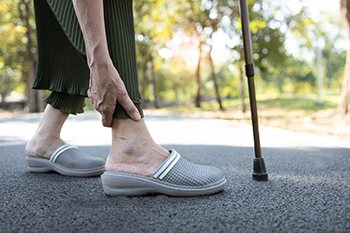
The importance of maintaining good foot care increases as we age. This may be difficult to do as the aging process occurs, and many seniors may need to have a family member or caregiver help them. It is beneficial to wear shoes that fit correctly, and this may help to prevent bunions, hammertoes, and other uncomfortable foot conditions from developing. It is helpful for the toenails to be trimmed weekly, which may be easier to accomplish after a bath or shower when they are softer. Performing gentle foot stretches can help with blood flowing properly, and physical activity may slowly be increased. Many seniors find it can be difficult to look at the bottom of the feet for any cuts that have developed, and often use a mirror. If you would like to have more knowledge about elderly foot care, it is suggested that you consult with a podiatrist who can provide you with useful information.
Proper foot care is something many older adults forget to consider. If you have any concerns about your feet and ankles, contact Dr. Joshua David Scoll from Pennsylvania. Our doctor can provide the care you need to keep you pain-free and on your feet.
The Elderly and Their Feet
As we age we start to notice many changes in our body, but the elder population may not notice them right away. Medical conditions may prevent the elderly to take notice of their foot health right away. Poor vision is a lead contributor to not taking action for the elderly.
Common Conditions
- Neuropathy – can reduce feeling in the feet and can hide many life-threatening medical conditions.
- Reduced flexibility – prevents the ability of proper toenail trimming, and foot cleaning. If left untreated, it may lead to further medical issues.
- Foot sores – amongst the older population can be serious before they are discovered. Some of the problematic conditions they may face are:
- Gouging toenails affecting nearby toe
- Shoes that don’t fit properly
- Pressure sores
- Loss of circulation in legs & feet
- Edema & swelling of feet and ankles
Susceptible Infections
Diabetes and poor circulation can cause general loss of sensitivity over the years, turning a simple cut into a serious issue.
If you have any questions please feel free to contact one of our offices located in Philadelphia, Bensalem, and Fairless Hills, PA . We offer the newest diagnostic and treatment technologies for all your foot and ankle needs.
How to Know if You Have a Plantar Fibroma

A plantar fibroma causes soft tissue swelling in the sole of the foot. Sometimes when a patient has this affliction, one or more nodules can form in the soft tissue of the feet. It can happen in one foot or both feet at the same time. This condition can cause painful swelling in the feet and walking can be difficult. Plantar fibromas can be confused with benign Morton neuromas, cysts or more serious and malignant sarcomas. If you have swelling or uncomfortable foot nodules, it is strongly suggested that you make an appointment with a podiatrist. This foot and ankle expert can provide a proper diagnosis using radiographic imaging and suggest appropriate treatment.
A plantar fibroma may disrupt your daily activities. If you have any concerns, contact Dr. Joshua David Scoll of Pennsylvania. Our doctor can provide the care you need to keep you pain-free and on your feet.
Plantar Fibroma
A plantar fibroma is a fibrous knot in the arch of the foot. It is embedded in the plantar fascia which is a band of tissue that extends from the heel to the toes along the bottom of the foot. There can be multiple plantar fibromas in the feet at the same time. There are no known causes for this condition. If you have a plantar fibroma, there will be a bump in the arch of your foot that cannot be missed. Any associated pain is most often due to a shoe rubbing against the nodule. Non-surgical options, such as steroid injections, physical therapy, and orthotics should be tried first. Surgery is a last resort and is the only thing that will remove a plantar fibroma entirely. Consult with a podiatrist for a proper diagnosis and to determine the treatment regimen that is right for you.
What Causes a Plantar Fibroma?
While there are no specific causes identified, a plantar fibroma can possibly come from genetic predisposition or the formation of scar tissue that forms from healing the tears in the plantar fascia.
What Are the Symptoms of a Plantar Fibroma?
There will be a noticeable lump in the arch of the foot that may or may not cause pain. If pain is felt, it is typically because a shoe is rubbing up against the lump or when walking or standing barefoot.
Treatment and Prevention
A plantar fibroma will not disappear without treatment, but it can get smaller and be a non-issue. If pain persists, a podiatrist examines the foot and when the arch of the foot is pressed, pain can be felt down to the toes. An MRI or biopsy might be performed to help diagnose or evaluate the plantar fibroma. The following non-surgical options are generally enough to reduce the size and pain of these nodules:
- Steroid injections
- Orthotics
- Physical therapy to help apply anti-inflammatory creams on the bump
Surgery is considered if the mass increases in size and the patient continues to feel pain after non-surgical methods are tried.
If you have any questions please feel free to contact one of our offices located in Philadelphia, Bensalem, and Fairless Hills, PA . We offer the newest diagnostic tools and technology to treat your foot and ankle needs.
More...
Simple Methods That Can Prevent Running Injuries

People who enjoy running and jogging are aware of how a running injury can interrupt this hobby. The importance of preventing running injuries ranks high among runners, and there are effective methods that can accomplish this. It is beneficial to stay hydrated by drinking plenty of water, which may help to prevent foot cramps. Stretching before and after running is effective in keeping the muscles limber, in addition to wearing running shoes that fit correctly. Many runners find it is better for their body to gradually change running surfaces, if desired, and to recover for an adequate amount of time. There are several types of running injuries, which may be prevented by taking care of the body. If you would like more information about how to do this, it is suggested that you consult with a podiatrist who can present you with effective tips on how to prevent running injuries.
All runners should take extra precaution when trying to avoid injury. If you have any concerns about your feet, contact Dr. Joshua David Scoll of Pennsylvania. Our doctor will treat your foot and ankle needs.
How to Prevent Running Injuries
There are a lot of mistakes a runner can make prior to a workout that can induce injury. A lot of athletes tend to overstretch before running, instead of saving those workouts for a post-run routine. Deep lunges and hand-to-toe hamstring pulls should be performed after a workout instead of during a warmup. Another common mistake is jumping into an intense routine before your body is physically prepared for it. You should try to ease your way into long-distance running instead of forcing yourself to rush into it.
More Tips for Preventing Injury
- Incorporate Strength Training into Workouts - This will help improve the body’s overall athleticism
- Improve and Maintain Your Flexibility – Stretching everyday will help improve overall performance
- “Warm Up” Before Running and “Cool Down” Afterward – A warm up of 5-10 minutes helps get rid of lactic acid in the muscles and prevents delayed muscle soreness
- Cross-Training is Crucial
- Wear Proper Running Shoes
- Have a Formal Gait Analysis – Poor biomechanics can easily cause injury
If you have any questions, please feel free to contact one of our offices located in Philadelphia, Bensalem, and Fairless Hills, PA . We offer the newest diagnostic and treatment technologies for all your foot care needs.
Various Methods to Exercise the Feet
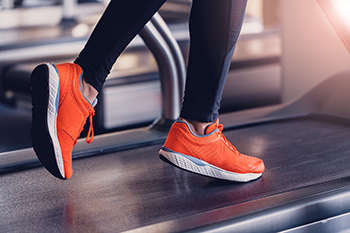
The feet can become strong when a consistent exercise regime is practiced. There are 26 bones, numerous tendons, and several ligaments that comprise each foot. Yoga has effective exercise and stretching techniques that target strengthening the feet. A heel sit is done by sitting on one foot at a time while kneeling on the other foot, and a stretch can be felt as the back foot is elongated. Calf raises can be equally as successful in keeping the feet strong. Many people enjoy having reflexology sessions, which are done by exerting pressure on various areas of the foot. This may be an effective method of strengthening the feet. Research has indicated that people who enjoy deadlifting may benefit by performing this type of strength training while barefoot. If you would like to learn more about what type of exercises can help the feet, it is suggested that you confer with a podiatrist who can provide you with the information you are seeking.
Exercising your feet regularly with the proper foot wear is a great way to prevent injuries and build strength. If you have any concerns about your feet, contact Dr. Joshua David Scoll from Pennsylvania. Our doctor can provide the care you need to keep you pain-free and on your feet.
Exercise for Your Feet
Exercise for your feet can help you gain strength, mobility and flexibility in your feet. They say that strengthening your feet can be just as rewarding as strengthening another part of the body. Your feet are very important, and we often forget about them in our daily tasks. But it is because of our feet that are we able to get going and do what we need to. For those of us fortunate enough to not have any foot problems, it is an important gesture to take care of them to ensure good health in the long run.
Some foot health exercises can include ankle pumps, tip-toeing, toe rises, lifting off the floor doing reps and sets, and flexing the toes. It is best to speak with Our doctor to determine an appropriate regimen for your needs. Everyone’s needs and bodies are different, and the activities required to maintain strength in the feet vary from individual to individual.
Once you get into a routine of doing regular exercise, you may notice a difference in your feet and how strong they may become.
If you have any questions please feel free to contact one of our offices located in Philadelphia, Bensalem, and Fairless Hills, PA . We offer the newest diagnostic and treatment technologies for all your foot and ankle needs.
Flip-Flops and Heel Pain
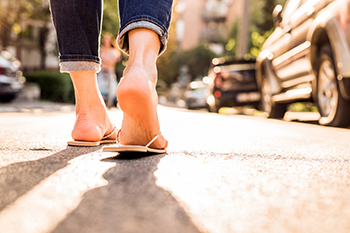
Flip-flops are often worn at the beach or around pools, but they are also worn as regular summertime footwear. These sandals are often thin-soled and offer little arch and foot cushioning support. Wearing these types of shoes long-term can lead to painful plantar fasciitis, which is a condition that affects the plantar fascia. This is the band of tissue that runs from the heel to the toes on the bottom of the foot, and may endure small tears or become overstretched. Plantar fasciitis can cause severe foot pain, particularly with the first steps after arising from sleep, or from walking for a prolonged period. If plantar fasciitis is not treated, a heel spur can develop, further irritating the foot. Flip-flops should be left for protecting feet in locker rooms or around the water, and more supportive shoes should be worn for other activities. If you have developed plantar fasciitis from wearing flip-flops, it is suggested that you consult with a podiatrist who can help you with treatment options, and recommend better summertime footwear.
Flip-flops can cause a lot of problems for your feet. If you have any concerns about your feet or ankles, contact Dr. Joshua David Scoll from Pennsylvania. Our doctor will assist you with all of your foot and ankle needs.
Flip-Flops and Feet
Flip-flops have managed to become a summer essential for a lot of people. While the shoes may be stylish and easy to slip on and off, they can be dangerous to those who wear them too often. These shoes might protect you from fungal infections such as athlete’s foot, but they can also give you foot pain and sprained ankles if you trip while wearing them.
When Are They Okay to Wear?
Flip-flops should only be worn for very short periods of time. They can help protect your feet in places that are crawling with fungi, such as gym locker rooms. Athlete’s foot and plantar warts are two common fungi that flip-flops may help protect your feet against.
Why Are They Bad for My Feet?
These shoes do not offer any arch support, so they are not ideal for everyday use. They also do not provide shock absorption or heel cushioning which can be problematic for your feet. Additionally, you may suffer from glass cuts, puncture wounds, and stubbed toes since they offer little protection for your feet.
More Reasons Why They Are Bad for Your Feet
- They Slow You Down
- May Cause Blisters and Calluses
- Expose Your Feet to Bacteria
If you have any questions, please feel free to contact one of our offices located in Philadelphia, Bensalem, and Fairless Hills, PA . We offer the newest diagnostic and treatment technologies for all your foot care needs.
Heel Pain Causes
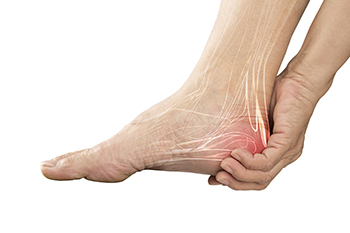
Having heel pain can cause difficulty in pursuing daily activities. It can happen from enduring a sprain or fracture, or there may be existing medical conditions that can lead to getting heel pain. Out of the 26 bones in each foot, the heel bone is the largest. Wearing shoes that do not fit correctly may cause common heel conditions, such as plantar fasciitis or heel spurs, to develop. Additional forms of heel pain can be from bursitis, or if an Achilles tendon injury has occurred. Swelling and redness may accompany heel pain, and it is often difficult to walk. Mild relief may be found when the affected foot is frequently elevated, and shoes that are worn fit properly. Some patients choose to put a heel lift or a shoe insert inside the shoe, which may help to reduce existing pain. If you have heel pain, it is strongly suggested that you consult with a podiatrist as quickly as possible. This type of doctor can determine what the cause is, and offer you the treatment method that is best for you.
Many people suffer from bouts of heel pain. For more information, contact Dr. Joshua David Scoll of Pennsylvania. Our doctor can provide the care you need to keep you pain-free and on your feet.
Causes of Heel Pain
Heel pain is often associated with plantar fasciitis. The plantar fascia is a band of tissues that extends along the bottom of the foot. A rip or tear in this ligament can cause inflammation of the tissue.
Achilles tendonitis is another cause of heel pain. Inflammation of the Achilles tendon will cause pain from fractures and muscle tearing. Lack of flexibility is also another symptom.
Heel spurs are another cause of pain. When the tissues of the plantar fascia undergo a great deal of stress, it can lead to ligament separation from the heel bone, causing heel spurs.
Why Might Heel Pain Occur?
- Wearing ill-fitting shoes
- Wearing non-supportive shoes
- Weight change
- Excessive running
Treatments
Heel pain should be treated as soon as possible for immediate results. Keeping your feet in a stress-free environment will help. If you suffer from Achilles tendonitis or plantar fasciitis, applying ice will reduce the swelling. Stretching before an exercise like running will help the muscles. Using all these tips will help make heel pain a condition of the past.
If you have any questions please contact one of our offices located in Philadelphia, Bensalem, and Fairless Hills, PA . We offer the newest diagnostic and treatment technologies for all your foot and ankle needs.




